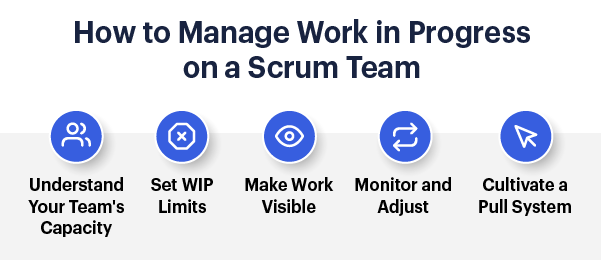Learn about purchasing for teams

In scrum, numerous concepts compete for a team's attention—backlog items, sprint goals, story points, velocity, and more. Yet, one term often lurks in the background, overlooked but incredibly impactful: Work In Progress or WIP.
Although WIP may sound like a term that belongs strictly to manufacturing or kanban, it’s crucial to recognize its profound potential influence on scrum teams. Understanding and effectively managing WIP can mean the difference between a scrum team operating like a finely tuned machine and one that perpetually flounders.
It is important to note that Work in Progress is not a concept that is incorporated into the definition of the scrum framework. However, given that scrum is built to inherently incorporate the lean principles of software development, it makes sense (though not mandatory) for a team to complement their use of scrum with lean concepts such as work-in-progress limits.
What Is Work In Progress (WIP)?
WIP refers to the product backlog items a team is working on but still needs to complete. In simpler terms, the work is "in progress." This might seem straightforward, but the devil is in the details. WIP doesn’t only affect the current sprint; it has a ripple effect that influences future sprints, backlogs, and even the team’s overall performance and well-being.
The Importance of Managing WIP in a Scrum Team
Streamlining Workflows
A team that has a well-managed WIP is a team that understands its capacity. This ensures that work flows through the scrum process more smoothly. No one is overloaded, and there are fewer bottlenecks.
Predictability and Reliability
By monitoring and managing WIP, scrum teams can offer better predictability and reliability. You'll be more accurate with your sprint plans, building stakeholder trust.
Enhancing Team Morale
Nothing dampens a team's spirit like the weight of unfinished work hanging over their heads. By controlling WIP, each team member knows they have a manageable load, which increases job satisfaction and decreases stress.
Flexibility
Well-managed WIP allows for flexibility. If there’s an unexpected issue or a new priority, a team with a lower WIP can adapt faster than a team bogged down with incomplete work.
Quality Over Quantity
Limiting WIP usually leads to higher-quality work. Quality naturally improves when developers focus on completing fewer tasks with fewer interruptions and less task overhead to manage (note: "developers" in this case means anyone who is using their skills to add value to the increment; in alignment with the Scrum Guide, "developers" is not technology-specific).
How to Manage Work in Progress on a Scrum Team
Understand Your Team's Capacity
Before you can manage WIP effectively, you must understand your team's capacity. Take an average of how many story points the team has completed in past sprints and use that as a guideline.
Set WIP Limits
Explicitly set limits for how many backlog items can be in progress at any time. Start with setting your WIP limit to one or two. That means your developers will need to learn to collaborate on fewer backlog items rather than everyone on the team working on something separate.
Check your WIP limit every day during the daily scrum. If there are more backlog items in progress than the limit allows, stop work on the backlog items above the limit and concentrate developer effort on the product backlog items within the WIP limit.
Make Work Visible
Use a scrum board to make all backlog items—and their statuses—visible to the entire team. Whether digital or physical, this board should be easily accessible and up to date.
Monitor and Adjust
During each sprint retrospective, check to see how practical your WIP limits are. Are backlog items getting completed more quickly? Is the quality up to standard? If quality is suffering, drop your WIP limit. Remember, never raise your WIP limit. The goal isn’t to be good at getting more done simultaneously. The goal is to be great at focusing on one or two things at a time and attacking them.
Cultivate a Pull System
Instead of pushing work, developers should pull new tasks only when they have the capacity and no one else on the team needs help. This naturally enforces WIP limits and encourages individual responsibility.
Managing WIP isn’t a one-time activity; it’s an ongoing process that requires vigilance, discipline, and regular adjustment. By doing so, you're not just making your current sprint more manageable; you're setting the stage for sustained effectiveness, quality, and team satisfaction in the many sprints that will follow. It’s time for scrum teams to bring WIP out of the shadows and give it the attention it deserves to optimize workflows and realize agile principles.

Key Takeaways
- WIP is a critical, often overlooked aspect of scrum that can dramatically affect a team’s effectiveness and well-being.
- Benefits of managing WIP include streamlined workflows, predictability, enhanced team morale, and higher-quality output.
- To manage WIP effectively, understand your team’s capacity, set WIP limits, make work visible, monitor and adjust, and cultivate a pull system.
Understanding and managing WIP is like holding the rudder of a ship. A slight adjustment can make a massive difference in your journey. So take control, steer wisely, and watch your team sail smoothly towards its goals.
Unlock new possibilities as a Certified ScrumMaster
The Certified ScrumMaster course helps you gain the practical skills and mindset to guide teams toward success. Join a global community of professionals who make work more meaningful, one sprint at a time.











